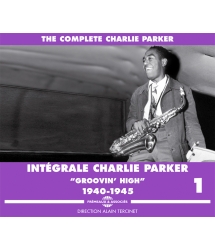Charlie ‘Yarbird’ Parker should need no introduction; recognised as one of the twentieth century’s true musical greats, he revolutionised saxophone playing in the forties. The recordings on these three CDs capture him in the very act, and additionally present jazz at a crucial time, when swing was shortly to give way to bebop, and when the blues could be played with a big band before r&b took over. Many of the recordings here were not made commercially - some are from radio broadcasts, some were made in concert, and a few, such as the fascinating opener, just Bird and his sax tackling ‘Honeysuckle Rose’ and ‘Body And Soul’, were never intended to be heard outside of the immediate circle. The sound quality therefore in not always pristine, but it does not really matter when the Jay McShann Octet hits its stride on a November 1940 radio broadcast. For readers of this magazine the highlight will be ‘Wichita Blues’, a wonderful example of the big band blues, but all are worth hearing. These seven tracks are all instrumentals, but Walter Brown shows up on the next session, McShann for Decca in Dallas, Texas, dating from six months later – Brown tackles the signature theme ‘Hootie Blues’, whilst the instrumentals, ‘Swingmatism’ and ‘Dexter Blues’ are, as you would expect, excellent showcases for the musicians’ abilities. Up next are four McShann titles from The Savoy Ballroom in 1942 (with the band introduced as ‘a brand new dance orchestra’!), with Hootie proving a closet West Ham fan and Bird Soloing at length, actually making ‘I’m Forever Blowing Bubbles’ listenable. A longer, rowdy version of ‘Hootie Blues’ sports some fine piano and another classy vocal by Mr. Brown, before the broadcast ends with the ‘musical hypnotism’ of ‘Swingmatism’. Clark Monroe’s Band then tackles ‘Cherokee’; Clark Monroe’s Upton House was where Bird would go after the evening shows with McShann had finished. The first CD closes with three McShann Decca titles from 1942, with Bird heavily featured on this trio of blues numbers (and Brown on two of them). CD two finds Bird accompanied just by guitar and drums for the first four titles, and these are followed by more private recordings made at the Bob Redcross Jam Sessions, with ‘Sweet Georgia Brown’ marking the first time that Bird and Dizzy Gillespie recorded together – the sound quality is poor but just about listenable. Next up are twelve tracks – three takes of ‘Tiny’s Tempo’ and five of ‘Romance Without Finance’, false start included – recorded for Savoy by the Tiny Grimes Quintet and these are definite hints of the coming sound of r&b, particularly with Tiny’s guitar ringing out loud and clear. The two takes of ‘I’ll Always Love You Just The Same’ feature Tiny’s ballad singing and ‘Romance’ has a fine jivey vocal. And does Bird’s tune ‘Redcross’ have a Scottish tinge? Following on is the (in)famous Clyde Hart’s All Stars 1945 session for Continental, at which singer Rubberlegs William drank Parker’s Benzedrine-laced coffee by mistake; the former dancer get progressively ‘out-of-it’, although some of the material is actually a little old-fashioned by the standards of the time. The same session continues on CD three, though trombonist Trummy Young takes over vocal duties from the unfortunate Williams, with the emphasis now on swing, then it is on to four tracks, rather scratchy studio tests, by another singer/trombonist, Clyde Bernhardt, backed by Parker and Jay McShann and his rhythm section. These are good, solid blues numbers from a singer who has often been undeservedly overlooked, and lead into a boogie-flavoured jazz piece from The Savoy Ballroom by the Cootie Williams Sextet, which also includes Sam ‘The Man’ Taylor on tenor sax. From here on though the focus of the set is much more firmly on the newly emerging sounds of bebop – bassist Slam Stewart is well in evidence on Dizzy Gillespie’s Musicraft session, Dizzy’s own well-known ‘Salt-Peanuts’ is included, and so too is Sarah Vaughan’s ‘Lover Man’ – Vaughan is also represented by a sophisticated three song session for Continental, accompanied by an octet. The final track, ‘Blue ‘N’ Boogie’ by the Dizzy Gillespie Quintet, recorded at The Academy Of Music, Philadelphia, is a useful glance into both how the musicians still used the blues and a reminder of how far the music changed in a relatively short space of time. All in all, an absolutely fascinating time capsule, capturing not only the evolution of one of the real innovators of jazz, but also a snapshot of a vibrant jazz and relatively sophisticated blues scene at a crucial time. It is not a set for the uninitiated though – some of the source material has not survived the intervening years too well, but those accustomed to listening to vintage music should not have too much trouble with the fluctuations in sound quality.
By Norman DARWEN – BLUES & RHYTHM











